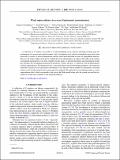Files in this item
Weak superradiance in arrays of plasmonic nanoantennas
Item metadata
| dc.contributor.author | Choudhary, Saumya | |
| dc.contributor.author | De Leon, Israel | |
| dc.contributor.author | Swiecicki, Sylvia | |
| dc.contributor.author | Awan, Kashif Masud | |
| dc.contributor.author | Schulz, Sebastian Andreas | |
| dc.contributor.author | Upham, Jeremy | |
| dc.contributor.author | Alam, M. Zahirul | |
| dc.contributor.author | Boyd, Robert W. | |
| dc.date.accessioned | 2019-10-29T09:30:03Z | |
| dc.date.available | 2019-10-29T09:30:03Z | |
| dc.date.issued | 2019-10 | |
| dc.identifier | 262191459 | |
| dc.identifier | 491ca282-e8b4-4277-b407-d2ffeaea7619 | |
| dc.identifier | 85073813564 | |
| dc.identifier | 000489819800009 | |
| dc.identifier.citation | Choudhary , S , De Leon , I , Swiecicki , S , Awan , K M , Schulz , S A , Upham , J , Alam , M Z & Boyd , R W 2019 , ' Weak superradiance in arrays of plasmonic nanoantennas ' , Physical Review. A, Atomic, molecular, and optical physics , vol. 100 , no. 4 , 043814 , pp. 1-9 . https://doi.org/10.1103/PhysRevA.100.043814 | en |
| dc.identifier.issn | 1050-2947 | |
| dc.identifier.other | ORCID: /0000-0001-5169-0337/work/63716691 | |
| dc.identifier.uri | https://hdl.handle.net/10023/18796 | |
| dc.description.abstract | A collection of N emitters can exhibit an N-fold broadening of the radiative linewidth resulting from the development of a macroscopic dipole moment. Such a broadening of the radiative linewidth has previously been observed in systems of several nanoparticles and has often been described in terms of superradiant behavior. However, the understanding of the physics behind the observed dependence of radiative linewidth on the number of irradiated nanoparticles is far from complete. In this paper, we present theoretical and experimental results that elucidate this broadening mechanism in plasmonic systems and draw a connection with the phenomenon of Dicke superradiance. We demonstrate that, in the limit where radiative broadening dominates, the extinction linewidth of a planar array of plasmonic nanoantennas scales linearly with the number of nanoantennas contained within a circle of radius equal to the resonant optical wavelength. We explain this classical phenomenon as a weak superradiance effect, which corresponds to the case in the Dicke model where only the ground state and the first collective excited state contribute to the enhanced radiation. | |
| dc.format.extent | 9 | |
| dc.format.extent | 1312861 | |
| dc.language.iso | eng | |
| dc.relation.ispartof | Physical Review. A, Atomic, molecular, and optical physics | en |
| dc.subject | QC Physics | en |
| dc.subject | TK Electrical engineering. Electronics Nuclear engineering | en |
| dc.subject | NDAS | en |
| dc.subject.lcc | QC | en |
| dc.subject.lcc | TK | en |
| dc.title | Weak superradiance in arrays of plasmonic nanoantennas | en |
| dc.type | Journal article | en |
| dc.contributor.institution | University of St Andrews. School of Physics and Astronomy | en |
| dc.identifier.doi | https://doi.org/10.1103/PhysRevA.100.043814 | |
| dc.description.status | Peer reviewed | en |
This item appears in the following Collection(s)
Items in the St Andrews Research Repository are protected by copyright, with all rights reserved, unless otherwise indicated.

